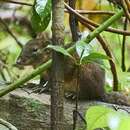en
names in breadcrumbs


Because of its long snout, Rhinosciurus closely resembles the tree shrew(Tupaiidae). In fact, the resemblence is so astonishing that many local people can not distinguish between the two and thus call them both by the same name, tupai.
Rhinosciurus laticaudatus is also known by several other names including Rhinosciurus incultus, Rhinosciurus leo, Rhinosciurus peracer, Rhinosciurus rhionis, Rhinosciurus saturatus, and Rhinosciurus tupaioides.
(Grzimek 1975; Wilson and Reeder 1993)
Perception Channels: tactile ; chemical
US Migratory Bird Act: no special status
US Federal List: no special status
CITES: no special status
IUCN Red List of Threatened Species: near threatened
Although R. laticaudatus is onmivorous, it is one of only a few species of squirrels that is mainly insectivorous. Rhinosciurus eats a variety of foods ranging from insects and small non-insect invertebrates to fruits. The stomach of a trapped specimen was found to contain insects and earthworms. A living specimen was observed eating almost 30 grasshoppers and 12 earthworms a day. Its diet was also supplemented with a banana and plenty of water. These squirrels are attracted by conventional baits, but rarely eat much of them.
Rhinosciurus is highly modified for its typical small-animal diet of insects and earthworms. Its long, tapered snout, reduced upper incisors, slender lower incisors and long, highly protrusible tongue are good adaptations for life as an insectivore on the forest floor. The teeth of older specimens are usually worn down significantly. This is probably due to the dirt and grit taken in when eating insects. (Lekagul 1977; Medway 1969; Nowak 1999; Parker 1989)
Foods eaten include: ants, termites, beetles, earthworms, grasshoppers and fruit.
Animal Foods: insects; terrestrial non-insect arthropods; terrestrial worms
Plant Foods: fruit
Primary Diet: carnivore (Insectivore )
The long-nosed squirrel is widely distributed throughout the Malay Peninsula, southern Thailand, Riau Archipelago, Borneo, Tioman, Sumatra, the Natuna Islands, and the Sunda Islands. (Lim 1999; Medway 1969; Nowak 1999; Chasen 1946)
Biogeographic Regions: oriental (Native )
Long-nosed squirrels are usually found inhabiting primary and secondary tall forests. They have also been found in the lowlands and hills of Sumatra, Borneo, and intervening islands at elevations as high as 900 meters above sea level. These squirrels forage on the ground and nest in hollow logs. (Chasen 1946; Francis 1985; Lekagul 1977; Medway 1969; Nowak 1999)
Range elevation: 0 to 900 m.
Habitat Regions: tropical ; terrestrial
Terrestrial Biomes: forest
The length of the head and the body of R. laticaudatus is approximately 185 to 242 mm, while the tail is 95 to 150 mm. The hind feet are usually 42 to 49 mm. Rhinosciurus laticaudatus has an interesting pelage. The coloring of the head and dorsal fur can vary from reddish brown to a grizzled olive brown. The sides and underparts of this squirrel are white or yellowish white. The short, bushy tail is often held upwards and has gray fur with white tips.
The most defining characteristic of Rhinosciurus is its elongated rostrum. Its snout is longer than that of any other Thai squirrel. The lower incisors are long and slender, while the upper incisors are tiny and barely functional. On each side of the upper jaw, there are two relatively simple premolars. The tongue is very long and protrusible. (Francis 1985; Lekagul 1977; Medway 1969; Nowak 1999; Parker 1989; Tate 1947)
Range mass: 187 to 255 g.
Range length: 290 to 392 mm.
Other Physical Features: endothermic ; bilateral symmetry
Rhinosciurus usually nests in hollow logs. Females have two pairs of mammae and their litters can range from one to two offspring. The offspring are born both blind and naked. (Hayssen et al. 1964; Nowak 1999)
Range number of offspring: 1 to 2.
Average number of offspring: 1.3.
Key Reproductive Features: iteroparous ; gonochoric/gonochoristic/dioecious (sexes separate); sexual ; fertilization ; viviparous
Parental Investment: altricial ; female parental care
The shrew-faced squirrel (Rhinosciurus laticaudatus), also known as the long-nosed squirrel, is a species of rodent in the family Sciuridae. It is monotypic within the genus Rhinosciurus.[2] It is found in forests in Peninsular Malaysia (possibly also in adjacent southern Thailand), Singapore, Sumatra and Borneo. This peculiar, terrestrial squirrel mainly feeds on insects and earthworms.[3] It quite closely resembles a Tupaia treeshrew in appearance, but the shrew-faced squirrel can be recognized by its shorter gape, and shorter and more bushy tail.[3]
The shrew-faced squirrel (Rhinosciurus laticaudatus), also known as the long-nosed squirrel, is a species of rodent in the family Sciuridae. It is monotypic within the genus Rhinosciurus. It is found in forests in Peninsular Malaysia (possibly also in adjacent southern Thailand), Singapore, Sumatra and Borneo. This peculiar, terrestrial squirrel mainly feeds on insects and earthworms. It quite closely resembles a Tupaia treeshrew in appearance, but the shrew-faced squirrel can be recognized by its shorter gape, and shorter and more bushy tail.